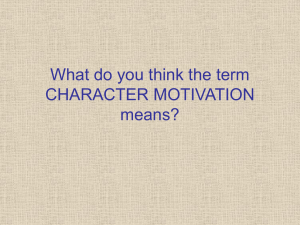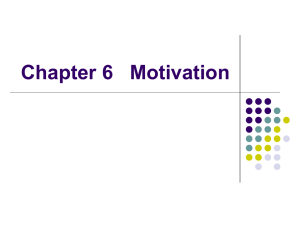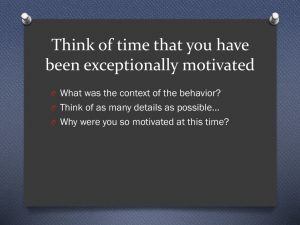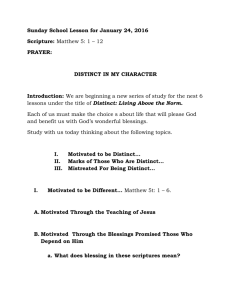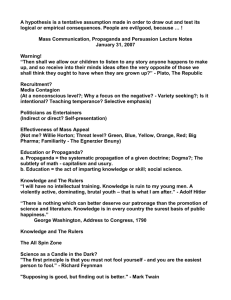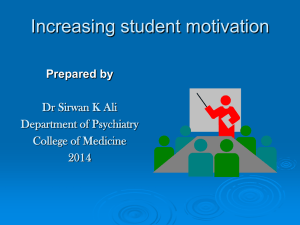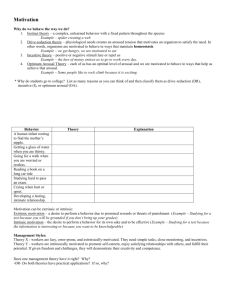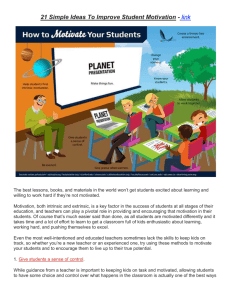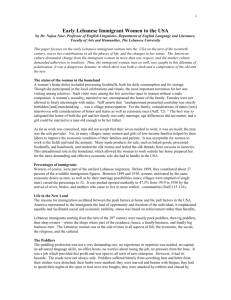Chapter 7: Motivation (also look at the PP on ecollege for additional
advertisement
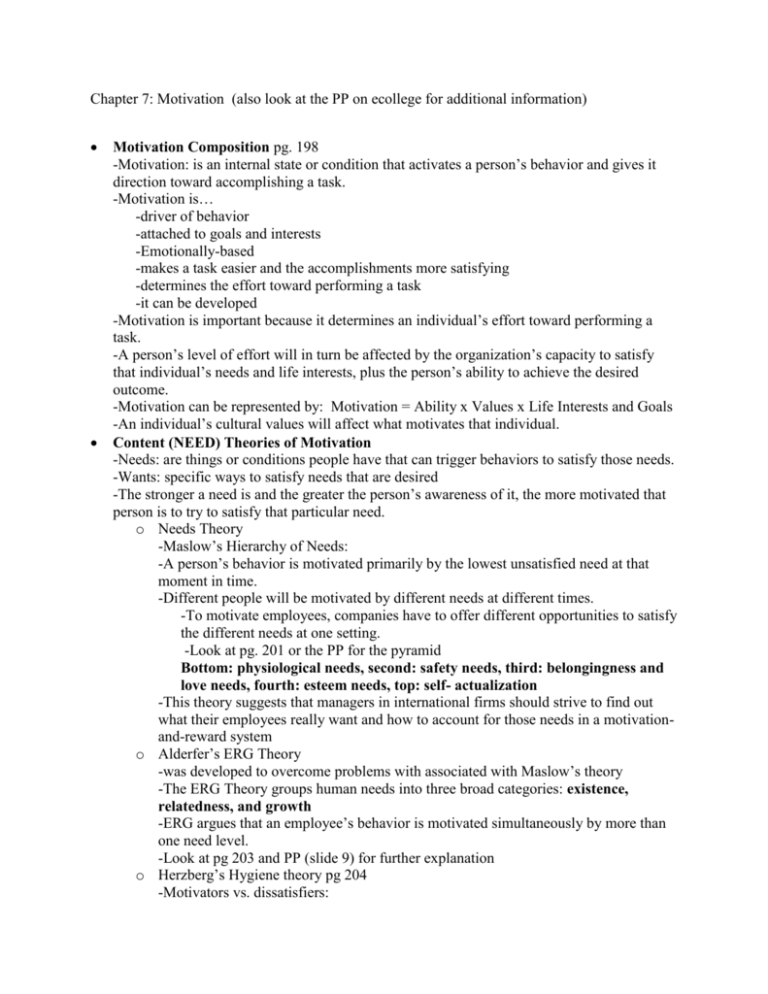
Chapter 7: Motivation (also look at the PP on ecollege for additional information) Motivation Composition pg. 198 -Motivation: is an internal state or condition that activates a person’s behavior and gives it direction toward accomplishing a task. -Motivation is… -driver of behavior -attached to goals and interests -Emotionally-based -makes a task easier and the accomplishments more satisfying -determines the effort toward performing a task -it can be developed -Motivation is important because it determines an individual’s effort toward performing a task. -A person’s level of effort will in turn be affected by the organization’s capacity to satisfy that individual’s needs and life interests, plus the person’s ability to achieve the desired outcome. -Motivation can be represented by: Motivation = Ability x Values x Life Interests and Goals -An individual’s cultural values will affect what motivates that individual. Content (NEED) Theories of Motivation -Needs: are things or conditions people have that can trigger behaviors to satisfy those needs. -Wants: specific ways to satisfy needs that are desired -The stronger a need is and the greater the person’s awareness of it, the more motivated that person is to try to satisfy that particular need. o Needs Theory -Maslow’s Hierarchy of Needs: -A person’s behavior is motivated primarily by the lowest unsatisfied need at that moment in time. -Different people will be motivated by different needs at different times. -To motivate employees, companies have to offer different opportunities to satisfy the different needs at one setting. -Look at pg. 201 or the PP for the pyramid Bottom: physiological needs, second: safety needs, third: belongingness and love needs, fourth: esteem needs, top: self- actualization -This theory suggests that managers in international firms should strive to find out what their employees really want and how to account for those needs in a motivationand-reward system o Alderfer’s ERG Theory -was developed to overcome problems with associated with Maslow’s theory -The ERG Theory groups human needs into three broad categories: existence, relatedness, and growth -ERG argues that an employee’s behavior is motivated simultaneously by more than one need level. -Look at pg 203 and PP (slide 9) for further explanation o Herzberg’s Hygiene theory pg 204 -Motivators vs. dissatisfiers: Not all needs are motivators, some can be considered de-motivators if they are not met. -Intrinsic vs. Extrinsic motivation: *Intrinsic motivation: internal drivers that guide effort and behavior, such as needs for achievement, need for participation, need for “making a difference” need for differentiation. *Extrinsic motivation: external factors that influence behavior, such as salary, supervision, working conditions, security. -Extrinsic factors are necessary for the desired behavior, but they do not motivate people to do more or better. -On the other hand, they are de-motivators, because they will make people do less, if they are not present. o McClelland’s Learned Needs (pgs. 205- 208) *Need for Achievement (nAch): -people with a high nAch want to accomplish reasonably challenging goals through their own efforts -They prefer working alone rather than in teams and chose tasks with a moderate degree of difficulty -They also typically prefer positive feedback and recognition for their success --Must win at any cost and must be on top and receive credit --People with low nAch fear failure and avoids responsibility. *Need for affiliation (nAff) -Refers to a desire for approval from others, and as a result, it means conforming to their wishes and expectations, and avoiding conflict. People with strong nAff want to form positive relationships with others… --People with high nAff: demand blind loyalty and harmony. They do not tolerate disagreement. --People with low nAff: They remain aloof and maintain social distance. *Need for Power (nPow): -refers to a desire to exercise authority over people and resources. --People with high nPow: are motivated by the opportunity to be in a position of authority -They also desire control of everyone and everything. They exaggerate their own position and resources --People with low nPow: are dependent/subordinate. They minimize their own position and resources -Applying Learned Needs Theory: McClelland argued that achievement, affiliation, and power needs are learned rather than instinctive, and are thus inculcated by cultures and societies. Process Theories of Motivation Content theories explain the different needs people have in different situations, whereas process theories describe the process through which need deficiencies are translated into behavior. The three most popular process-motivation theories below: o Expectancy Theory: is based on the idea that work effort is directed toward behaviors that people believe will lead to desired outcomes. -Work is directly related to desired outcomes. -The effort an individual puts towards a task depends on three factors: --Effort to performance effect (E->P): how much the effort will affect performance. -is an individual’s perception that his or her effort will result in a particular level of performance --Performance to outcomes effect (P->O): how much of the performance will affect the outcome. -is the perceived probability that a specific behavior or performance level will lead to specific outcomes. This probability is derived from previous experience or social learning is derived from watching others. --Outcome valences (V): if the outcome is positive or negative (i.e. if it will bring satisfaction or dissatisfaction). -Valence refers to one’s anticipated satisfaction or dissatisfaction with an outcome. *look at pg 211 for further explanation -Expectancy Theory internationally: offers one of the best models available for predicting work effort and motivation in different cultures. o Equity Theory: explains how people develop perceptions of fairness in the distribution and exchange of resources. It explains what employees are motivated to do when they feel inequitably treated. -Perceptions of fairness: *Outcome/input ratio: how much you take back for how much effort you put in. *Comparison with others: one’s own outcome/input ratio compared to others’. *Equity evaluation: results of comparison -> fair or unfair? *Consequences of inequity: counterproductive motivations -> shirking, loafing, counterproductive work behavior, turnover, employee stress. -Equity sensitivity types: *1 to 1: expects the outcome/input ratio to be 1to 1 *Benevolent: do not mind putting in more than they take out. *Entitled: expects to take out more than what they put in. o Goal Setting: is the process of motivating employees and clarifying their role perceptions by establishing performance objectives -Goal setting potentially improves employee performance in two ways: first by adding to the intensity and persistence of effort, and then by giving employees clearer roles so that their effort can be directed toward behavior that will improve task performance. -Goal Setting… *Defining specific goals and objectives, with specific timeline *It helps clarifying steps and actions necessary to accomplish a task *Goals must have measurable outcomes and a deadline to be reasonable and feasible. *Motivator goals are: specific, relevant, challenging, committing, participative, and allow feedback. -Limitations (pg. 223) Goal setting has a few limitations. One problem is when goals are tied to monetary incentives, many employees may try to “game the system” by selecting easy goals, or negotiating performance goals that are already near completion. Another limitation is that goal setting cannot be applied to every performance dimension of every task. Employee Interest (pg 224) Life interests indicate whether an employee is likely to be interested in doing the job. Thus, motivation also concerns an employee and what they as individuals like to do.
